

PCs and Tablets: United Under the Cloud. Desktop Virtualization and the Death of the PC It may simply be a question of "when" not "if" a range of mobile computing devices displaces the PC.

Arthur Cole spoke with Anand Kekre, CEO, Vaultize. Are the PC's days really numbered? If current trends hold steady, it would seem that mobile devices will soon be the dominant client device for both consumers and business users, pushing the trusty desktop into a supporting role. The question, then, becomes how to integrate tablets and smartphones into enterprise data environments. Cole: Vaultize has added iPad and iPhone apps to its storage and sync services. Kekre: Mobile devices made their way into enterprise infrastructure through back door. Consumer services like Dropbox and iCloud have penetrated enterprises deeply in such a way that today important and sensitive corporate information is sitting in these clouds where the enterprises have no control. Cole: There is some talk about tablets replacing PCs as the new enterprise client.
Managing and Analyzing Data in the Era of the Cloud. Leveraging Analytics to Gain Competitive Business Advantage Cultural issues rather than the technology itself are the biggest impediment to the adoption of analytics.
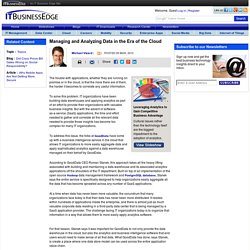
The trouble with applications, whether they are running on premise or in the cloud, is that the more there are of them, the harder it becomes to correlate any useful information. To solve this problem, IT organizations have been building data warehouses and applying analytics as part of an effort to provide their organizations with valuable business insights. But with the advent of software-as-a-service (SaaS) applications, the time and effort needed to gather and correlate all the relevant data needed to provide those insights has become too complex for many IT organizations.
According to GoodData CEO Roman Stanek, this approach takes all the heavy lifting associated with building and maintaining a data warehouse and its associated analytics applications off the shoulders of the IT department. Regulation, automation, and cloud computing. Chris Hoff, a former colleague now at Juniper Systems, and a great blogger in his own right, penned a piece last week about the weak underbelly of automation: our decreased opportunity to react manually to negative situations before they become a crisis.
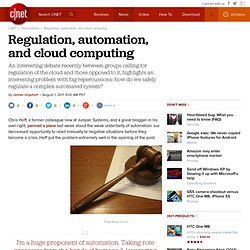
Hoff put the problem extremely well in the opening of the post: I'm a huge proponent of automation. Taking rote processes from the hands of humans & leveraging machines of all types to enable higher agility, lower cost and increased efficacy is a wonderful thing.However, there's a trade off; as automation matures and feedback loops become more closed with higher and higher clock rates yielding less time between execution, our ability to both detect and recover -- let alone prevent -- within a cascading failure domain is diminished. I've stated very similar things in the past, but Hoff went on to give a few brilliant examples of the kinds of things that can go wrong with automation. Is Amazon Web Services’ ‘SWF’ A New Workflow Manager?
It looks like Amazon Web Services may be launching a new workflow manager called SWF.
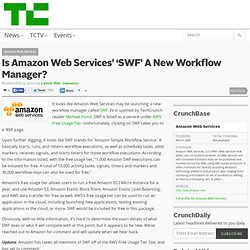
First spotted by TechCrunch reader Michael Hood, SWF is listed as a service under AWS’ Free Usage Tier. Unfortunately, clicking on SWF takes you to a ’404′ page. Upon further digging, it looks like SWF stands for ‘Amazon Simple Workflow Service.’ It basically starts, runs, and retains workflow executions, as well as schedules tasks, adds markers, receives signals, and starts timers for those workflow executions.
Getting Down to Earth About Cloud Integration. B2B Integration Gets Strategic in the Cloud A more strategic approach to cloud B2B integration is emerging.
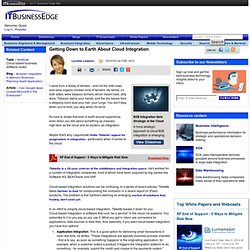
I came from a family of farmers - and not the milk-cows and raise-organic-chicken kind of farmers. My family, on both sides, were tobacco farmers, which meant hard, dirty work. Tobacco stains your hands, and the dry leaves from a stripping room dust your hair, your lungs. You don't stop when you're tired; you stop when it's done.
For Start-Ups, Sorting the Data Cloud Is the Next Big Thing. “My smartphone produces a huge amount of data, my car produces ridiculous amounts of really valuable data, my house is throwing off data, everything is making data,” said Erik Swan, 47, co-founder of Splunk, a San Francisco-based start-up whose software indexes vast quantities of machine-generated data into searchable links.

Companies search those links, as one searches Google, to analyze customer behavior in real time. Splunk is among a crop of enterprise software start-up companies that analyze big data and are establishing themselves in territory long controlled by giant business-technology vendors like Oracle and I.B.M. Founded in 2004, before the term “big data” had worked its way into the vocabulary of Silicon Valley, Splunk now has some 3,200 customers in more than 75 countries, including more than half the Fortune 100 companies. Macy’s uses Splunk’s software to observe its Web traffic in order to avoid costly down times, particularly during peak holiday shopping.
2012 - The Year Cloud Analytics Takes Off. 2012 will be the year that Cloud Analytics hits pay dirt.

Increasingly - and at an accelerating rate, data and applications are moving to the Cloud, and the old-fashioned on-premises Business Intelligence stacks are going to be supplanted by a new generation of Cloud-based analytic tools. Cloud computing traffic is growing at a 66% compound average growth rate and by 2015, Cloud will represent over 1/3 of data center traffic. Sunset for Traditional BI Vendors For the on-premises BI vendors, the clock is ticking. Their tool suites are based on old architectures. Tools for Cloud Application Monitoring - Cloud Talk. My last post covered the some challenges related to monitoring cloud applications.
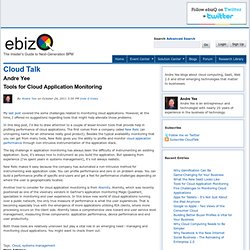
However, at the time, I offered no suggestions regarding tools that might help alleviate those problems. In this blog post, I'd like to draw attention to a couple of lesser-known tools that provide help in profiling performance of cloud applications. The first comes from a company called New Relic (an uninspiring name for an otherwise really good product). Besides the typical availability monitoring that you can get from many tools, New Relic gives you the ability to profile and monitor cloud application performance through non-intrusive instrumentation of the application stack. The big challenge in application monitoring has always been the difficulty of instrumenting an existing application.
Analytics in the cloud: a practical approach: MWD research library. In SaaS, you can’t assimilate, so integrate — Cloud Computing News. Trusted Cloud Services and Solutions. The ServiceMesh Agility Platform provides self-service, on-demand access to IT resources while maintaining governance, compliance and security.
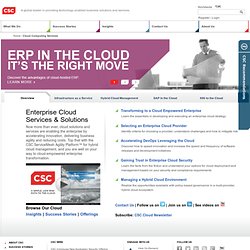
Empower your business users with the ServiceMesh Agility Platform. The Future of IT Outsourcing and Cloud Computing. IaaS: Innovators in cloud solutions Most have a cloud plan Click here to explore the data.

Survey: Companies Adopt the Cloud to Use Tablets, End Up Saving Less - ReadWriteCloud. One of the drivers of the current cloud computing revolution was supposed to be cost reduction. Even private cloud implementers are supposed to be spending considerably less on storage and computing power, by virtue of greater utilization and tolerance for commercial, off-the-shelf (COTS) components. But a global survey of some 3,645 enterprise cloud computing users over the last two months, conducted by TNS for professional business services provider CSC reveals a pair of startling discoveries: First, while most businesses are saving money, the amount in most cases ranges from slim to none. Second, businesses aren't really put off too much by that fact. ReadWriteCloud. AppexchangeWatch.com. Success in the Cloud Begins with Integration.
Now that cloud computing has turned from an “if” to a “when” proposition, enterprises of all sizes are asking a lot of questions beginning with “how.” How will we make the transition? Cloud computing: Fundamentals. 1. Learn the basics of cloud computing Cloud computing is a comprehensive solution that delivers IT as a service. Computers in the cloud are configured to work together and the various applications use the collective computing power as if they are running on a single system.
The articles and webcast highlight the fundamental concepts in the cloud computing business model as well as the key reasons to move to the cloud. 2. Assess enterprise applications for cloud migration. Without a doubt cloud computing offers advantages for enterprise operations: It can help reduce costs (for instance, by setting up and configuring an application testbed or by being able to add and subtract computing power when you need it).It can help you process large data sets faster (by balancing workloads where and when needed).It can help your business respond more quickly to changing conditions (by being able to apply business analytics to larger amounts of mixed-structure data in a more rapid way).
But how do you know whether an enterprise application is suited for the cloud? There are varied business, technology, and risk considerations which can have profound effect on the overall success of cloud initiatives in an enterprise, meaning there is no "one-size-fit-all" answer for whether an application "fits" in the cloud (which I will refer to as fitment). Some of the questions businesses need to ask themselves before undertaking cloud initiatives are: Assessment approach Figure 1. Www.cloudcom.org. 2011.cloudcom.org. The Top 20 Platform as a Service (PaaS) Vendors.
The Wisdom of Clouds: Which Sun Do You Orbit? I love cloud computing. I love the concept, I love many of the implementations, and I love the opportunity that such a major disruption creates for entrepreneurs and tech giants alike. There is much to be excited about, though the market is in its infancy. Gartner Lists Top 10 IT Technologies for 2012. Gartner Inc. has identified 2012’s top corporate IT technologies and the list includes a few heavyweight trends from this year, along with some new players. IDN looks at what Gartner says why next year will be pivotal for clouds, enterprise mobile, business intelligence, enterprise-facing apps stores and in-memory technologies.
Presented by Information Management. Blog. Infrastructure as a Service (IaaS)
How cloud entertainment will burst the digital stratosphere - Ireland's cloud news service - Siliconrepublic.com. The cloud is a US$20bn Smarter Commerce opportunity, IBM says - Ireland's cloud news service - Siliconrepublic.com. What cloud computing really means. Cloud computing is all the rage. "It's become the phrase du jour," says Gartner senior analyst Ben Pring, echoing many of his peers. The problem is that (as with Web 2.0) everyone seems to have a different definition. Cloud Computing May be a Shot in the Arm our Economy Needs. Amazon's cloud services get approval to operate under FISMA. Cloud Brokerage is Gaining Ground. All of a sudden, everyone is interested in cloud services brokerage. Well, by everyone, I mean end customers looking for an easier way to integrate cloud computing into their plans and vendors seeking a new set of markets to mine.
But no matter the interested party, one thing is clear.